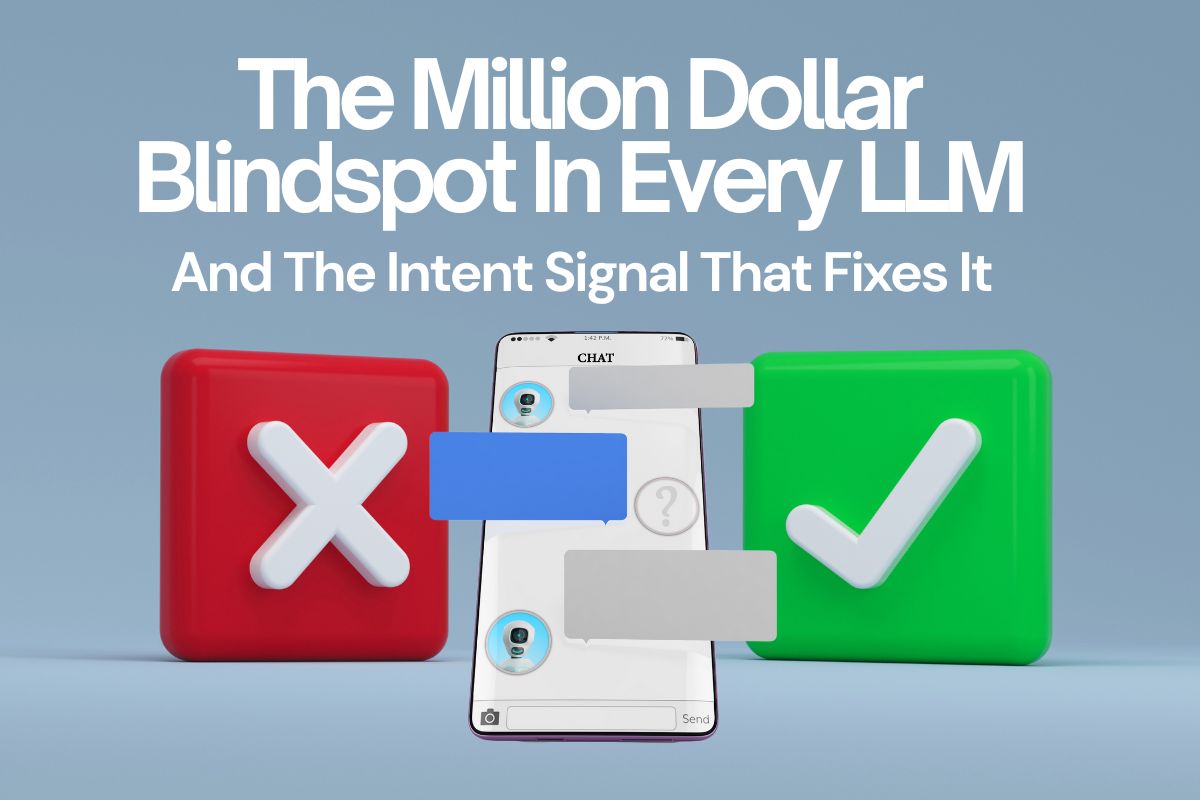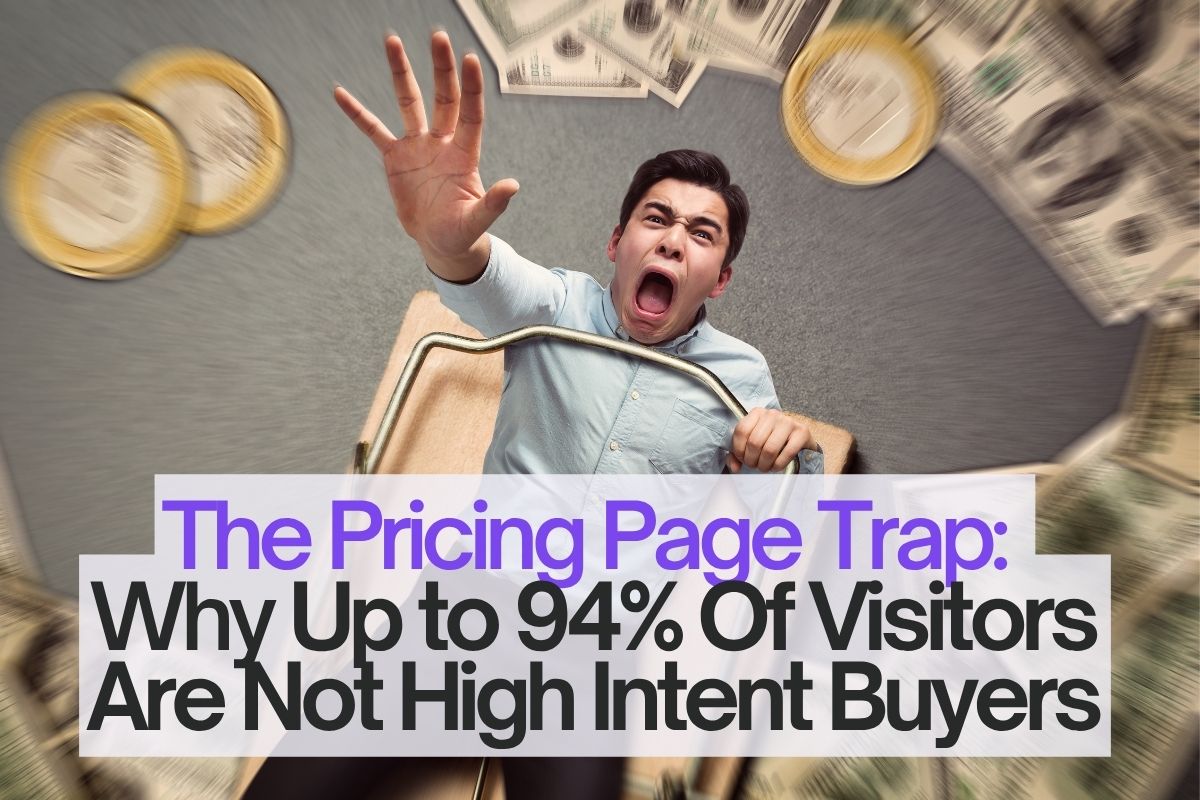In his bestselling book The ONE Thing, Gary Keller gives Marketing Leaders a powerful tool to prioritize their GTM efforts on activities that drive revenue. It’s a single question:
“What’s the ONE Thing I can do, such that by doing it, everything else will be easier or unnecessary?”
For Marketers, that ONE Thing is clear: we must deliver high-quality leads to Sales.
Not more leads, but better ones that shorten cycles, lift conversion rates, and most importantly: grow quality pipeline to help Sales consistently hit their quotas.
Yet, this is exactly where most GTM engines break down.
Data-driven marketing is only as effective as the accuracy of the data it’s built on. Without accurate signals at the start, every GTM motion runs on noise — inflating pipelines, wasting budgets and eroding Sales confidence.
Today, with the promise of Agentic AI, marketing leaders have found new hope to improve their GTM sales results. And for good reasons - AI has huge potential for GTM revenue teams.
However, AI agents and SDRs still don’t address the root cause of the problem. In fact, they only amplify and speed up the automation of GTM motions that run on noise.
The actual problem is the data driving GTM is only 20% accurate at best: 3rd-party intent signals, form fills, keywords, email clicks, content surges, page views, ID reveals, ABM segmentation and faulty lead scoring are too inaccurate, incomplete or fragmented.

This all results in poor-quality leads that inflate pipeline, waste budget, and leave Sales chasing shadows instead of real buyers. Marketing insists it delivered “qualified leads”. Sales insists they weren’t real. Finger-pointing grows and GTM team morale suffers.
The cost of bad data compounds across every GTM motion — stalling growth and leaving your GTM revenue engine unable to scale.
There has to be a better way.
My 15 Year Search For The ONE Signal
Over 15 years ago - long before “intent data” was even a phrase - I was facing the exact same challenge every enterprise GTM revenue leader still faces today...
How do we find more leads that are truly sales-ready?
At the time, we were running a commission-based live sales chat agency with over 200 sales agents. Chat was still in its infancy and we were one of a handful of companies in the space servicing global brands like Norton and Teamviewer.
They had enormous volumes of website traffic, but here was the pain: nobody could predict which website visitors were serious buyers.
We designed chatbots to pre-qualify leads before advancing them to the sales team to close via live chat. We were getting good results, but it felt like we were still flying blind and missing out on a lot of revenue and commissions.
Cast the net too wide and sales teams wasted time chasing the wrong people. Go too narrow - like only targeting “high buyer intent” pages and the vast majority of real buyers slip through completely missed and unseen.
We tried rules-based targeting but quickly realized our clients had as many as 77,000 different pathways a visitor could take on the website before buying!

Even with thousands of A/B split tests running every day, we were still missing too many buyers we could not detect - leaving lots of pipeline and revenue on the table.
We had to get better at finding and engaging sales-ready website visitors.
And today that gap is even more costly. According to DemandGen Reports:
“80% of B2B buyers initiate first contact once they’re 70% through their buying journey”.
Inspiration From an Airport Bookstore
Our breakthrough was triggered in 2018 when I picked up a book on Artificial Intelligence at a Logan Airport bookstore called Prediction Machines. With the premise of predicting human behavior using machine learning, it reminded me of Winston Churchill’s famous line: “behavior never lies”.
And that’s when it clicked. Just as a skilled salesperson can read a customer’s body language and behavior in a retail store, AI and machine learning could be trained to read and interpret the digital body language - in both microscopic and cumulative detail - of every website visitor.
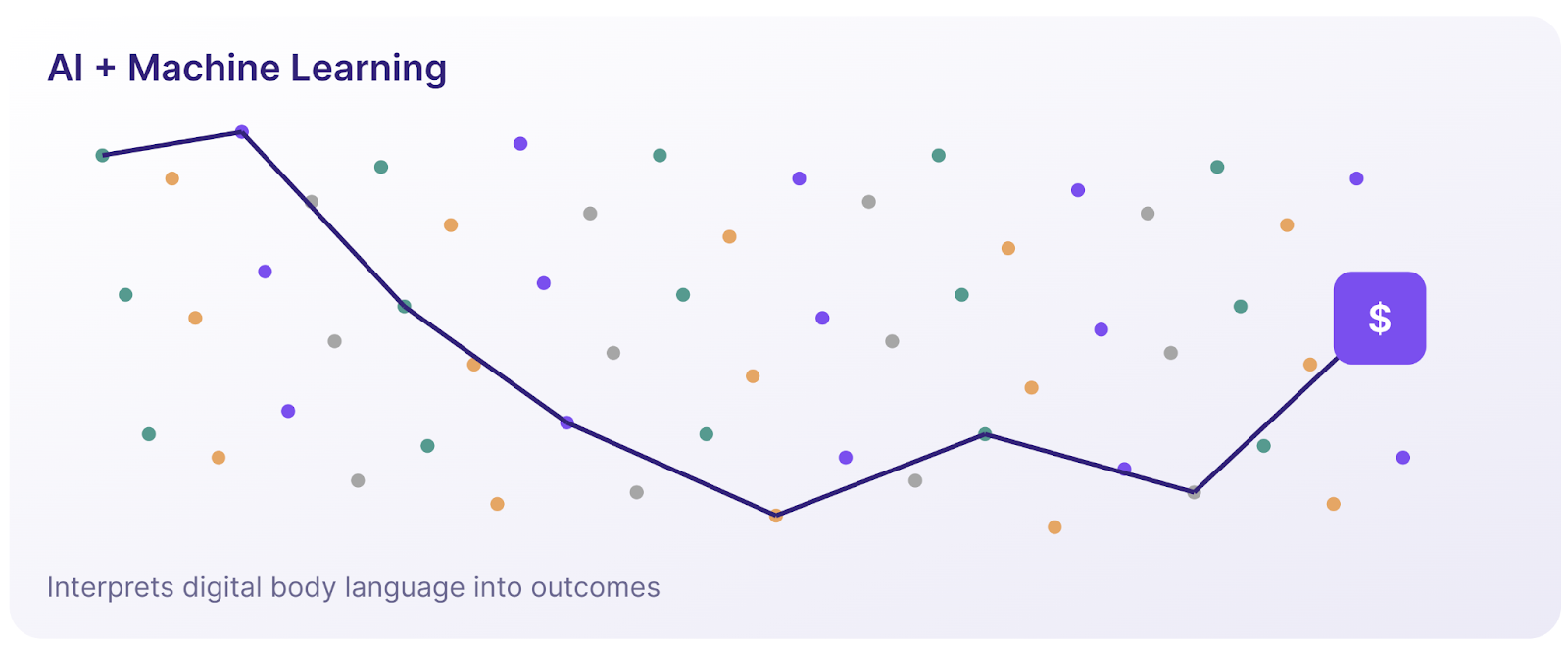
In other words, machine learning was the key. Because with our commission-based model, every sale we made for our clients had to be proven down to the decimal. Clients scrutinized every number, forcing us to track outcomes with ruthless precision.
Through years of relentless pressure, that discipline gave us something unique: a gold mine of hyper-clean, First-party data that showed exactly what behaviors led to sales across almost every industry and enterprise vertical.
Now we needed AI and machine learning to perfect the process at scale.
The ONE Signal Breakthrough
So, that’s what led up to building Lift AI and our unique model which detects, scores and segments website buyers into low, mid and high-intent with an incredible 85% accuracy.
We call this breakthrough the “ONE Signal” — Lift AI’s proprietary First-party buyer intent signal, generating sales-ready leads and pipeline directly from your website.
The ONE Signal is powered by Micro-Behavioral Analysis™, a machine learning model built from 15 years of training on buyer journey data from billions of website visits and millions of purchases across enterprise websites.
At over 85% accuracy, it's the most precise and profitable buyer-intent signal available today.
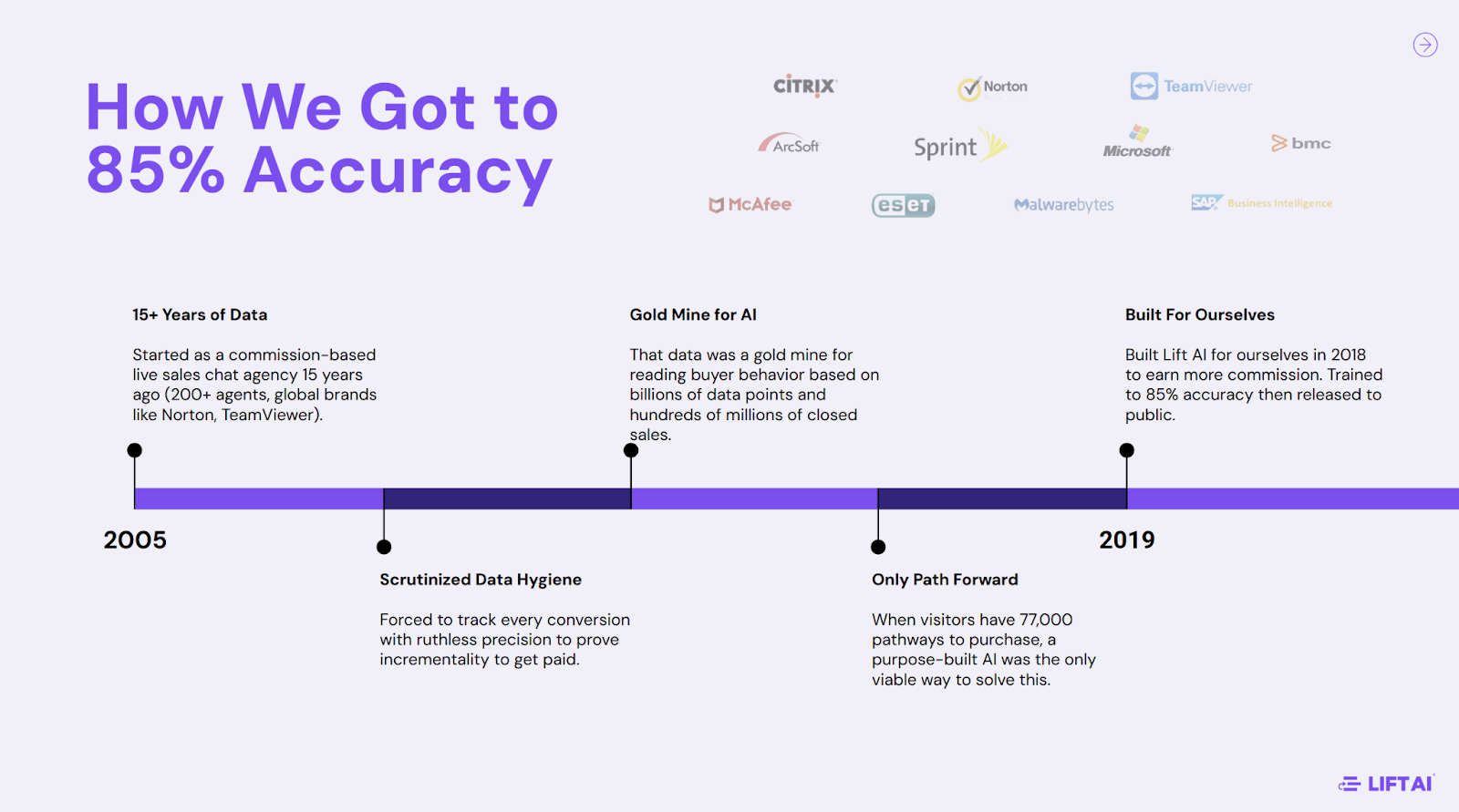
Our working theory has always been that your website traffic contains more sales-ready buyers than any other source. Which is a completely different model from 3rd party intent data, because whatever prospects do before coming to your website does not really matter very much. And it doesn’t matter what their name, company, IP or email address is.
What matters most is the totality of actual website visitor behavior, which includes every nuanced visitor activity imaginable. Because behavior never lies (if you can collect and test enough of it).
Suddenly, our sales agents knew exactly which visitors to engage and which to ignore, and our commissions grew considerably as we were able to prove a lift in incremental revenue for our clients. And we didn’t need any Personally Identifiable Information (PII).
The ONE Signal is the foundation of your signal-based GTM machine - empowering more profitable GTM playbooks than any other signal on the market. It also complements every other tool in your entire tech stack, which enables you to confirm ICP fit and enrich your lead data with context, relevancy and personalization. It also works all by itself, because buyer intent is king.
Nuanced buyer behavior is the ultimate Signal.
This is much more than a tech breakthrough - it’s the foundation for a new way to Go To Market, where signal accuracy replaces noise and hidden buyer journeys are revealed to power GTM engines - with the immediate and compounding benefits of sustainable revenue growth.
The result is faster pipeline velocity, higher conversion rates, stronger overall ROI, better data-driven attribution, funnel optimization and faster growth you can measure and trust.
What began as my struggle to solve one of marketing’s most frustrating problems has become The ONE Signal - the most accurate and powerful buyer intent signal on the market today.
Because when you can see exactly who’s sales-ready - everything else becomes easier.
The Primary GTM Problem: Inaccurate Intent Signals
Every GTM engine today runs on data. But most engines break down at both ends of the funnel. Because inaccurate data inputs pollute every downstream motion, leading to attribution models that fail to connect activity to revenue. This clouds proof of what’s working and what’s not, so until data inputs are fixed - your GTM strategy will continue to be noisy and not optimized.
Predicting human buying behavior is the most difficult challenge in all of marketing, which is why split testing is so vital to achieving results and why we became experts in testing, running tens of thousands of split tests on enterprise websites every day, before machine learning.
So it’s no surprise today’s massive market of “intent data” struggles with accuracy. Every traditional method of predicting in-market buyer behavior at scale has simply hit a ceiling - delivering mediocre results that ripple through every GTM motion.
At the heart of this problem is that GTM teams are forced to rely on weak signals; inaccurate third-party intent data, flawed lead scoring, low intent form fills, singular page views, limited ID reveals, and messy CRM records — none of which provide the accuracy needed to drive sustainable growth.
The main difference between noise and signal comes down to one thing: ACCURACY.
The problem with third-party intent data and most first-party signals is they are no more than 20% accurate. Leading research confirms this problem.
An MIT study (Neumann, Tucker, & Subramanyam) found that off-the-shelf intent data segments performed “no better at reaching the right person than random prospecting”.
In other words, the data that GTM teams are told will make them “smarter” often leaves them no further ahead than picking accounts out of a hat!
Forrester’s report (Brett Kahnke) echoed this conclusion:
“Despite all the benefits of intent data, too often the reality doesn’t meet the expectations. This is particularly true in sales.”

Where’s the Proof?
Have you ever asked your intent provider to prove the accuracy of their data?
Do they offer proof or attribution or an accuracy dashboard you can actually see?
When building Lift AI, we built a Buyer Intent Data Accuracy Dashboard for ourselves as the one critical metric to ensure the ONE Signal is working effectively on every client website. This dashboard is updated in real-time and can be viewed 24/7 - so we can continuously monitor and tune the accuracy of every clients’ buyer intent data - to optimize your conversions and ROI.
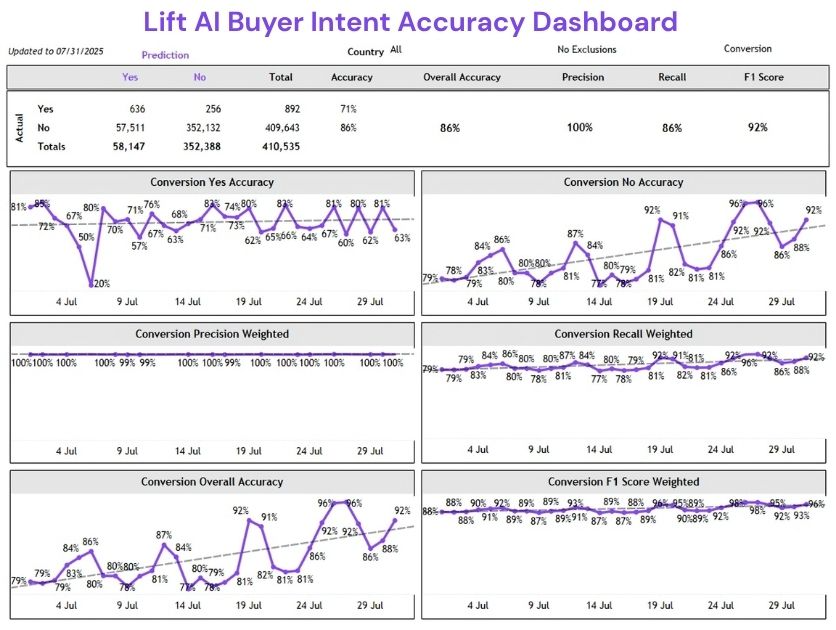
The GTM data input problem is simple but devastating: if you can’t trust the accuracy of the intent data that fuels your GTM, every output and downstream motion — from sales prioritization to marketing workflows and ad spend — is compromised before it even begins.
This results in a GTM system that ends with weak, uncertain and unsustainable results.
When inaccurate data poisons the top of your funnel, attribution at the bottom is clouded, which leaves Marketing unable to prove their impact, Sales unable to trust Marketing and executives without the clarity they need to strategically allocate budget and drive sustainable GTM growth.
This is plainly evident in the collapsing ROI from most GTM engines today.
According to a BenchSights study in 2025:
“Public companies now spend an average of $2.24 in Sales and Marketing for every $1.00 of new ARR they bring in”.
Clearly, GTM engines are breaking down - we believe the root cause is bad GTM data.
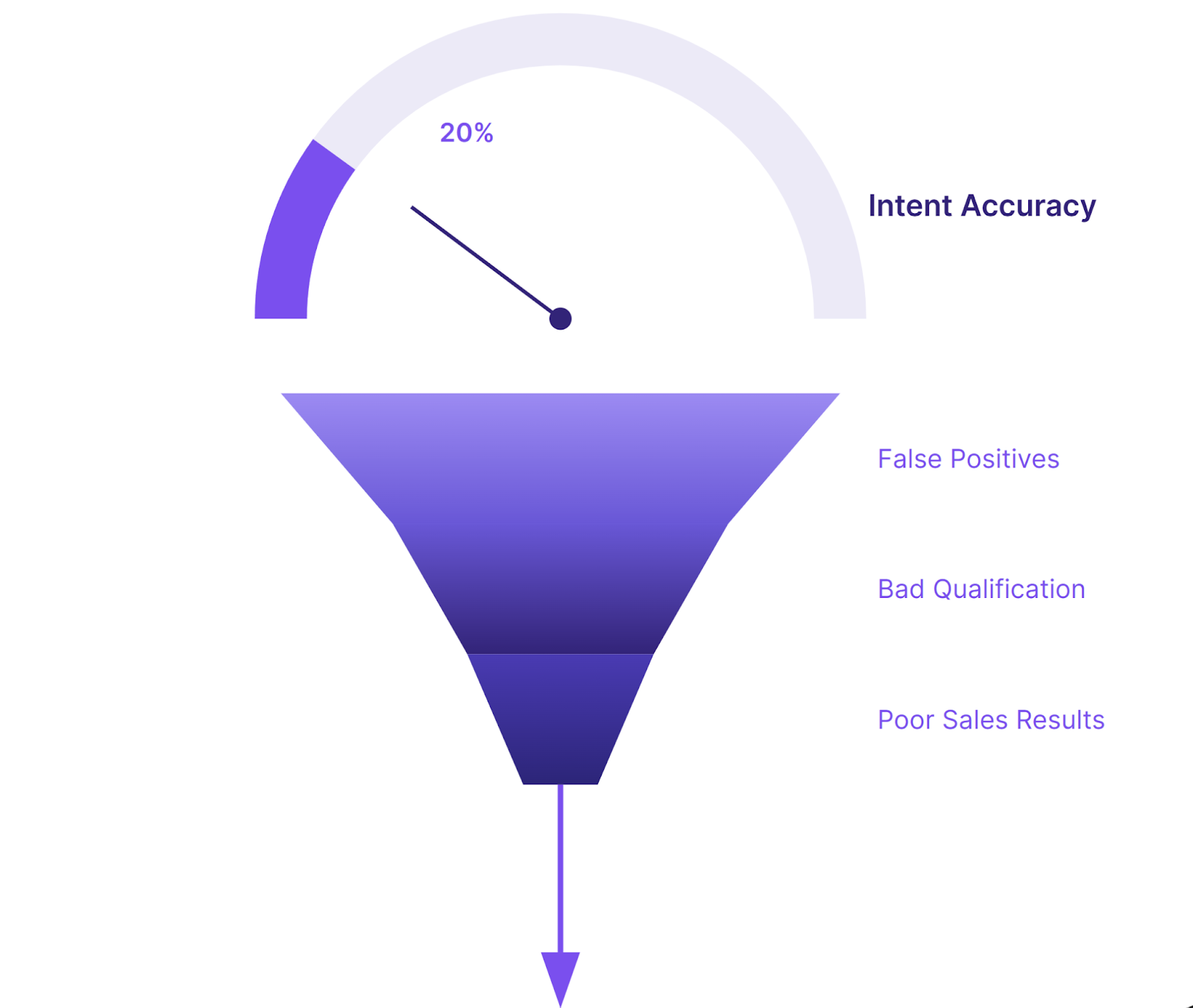
Fortunately, the ONE Signal solves this data accuracy problem - a core GTM challenge.
Let’s quickly look at why the primary types of intent data are falling short.
The Two Types of Signal-Based Sales and Marketing Data That Are Failing
Over the last decade, few concepts in marketing have had as much allure as “intent data.” The idea was intoxicating: what if you could know exactly who is ready to buy, right now? Vendors across the industry turned this idea into a multi-billion-dollar category, convincing GTM teams that intent signals were the shortcut to pipeline and revenue.
Broadly speaking, there are two types of data fueling GTM revenue engines: First-party data (internal) and third-party data (external). Both have their place, but the accuracy, impact and value of each type of data are much different.
The False Promise of 3rd-Party Intent Data
Third-party data is gathered from external sources — publishers, data brokers, and vendors — which aggregate signals like content consumption, popular topic-based keyword searches, firmographics, technographics, IP-level tracking, cookie matching and more.
Although it promises sales efficiency and scale, it has major limitations:
- Vague or ambiguous signals: “Intent” may not mean buying. For example, keywords and topic searches could just be competitor research, benchmarking, or general curiosity, with no indication of buying stage, budget, or timeline.
- Fragmented and incompatible: Isolated signals are pieced together from multiple publishers and sources, creating inconsistent quality and incompatible data points. It’s not as simple as “A+B=C” when there’s actually no correlation.
- Latency and delays: Data is often delayed by days or weeks, so opportunities may have already shifted by the time you act.
- Privacy and compliance risks: Regulations (GDPR, CCPA, etc.) and browser privacy changes limit what can be collected and shared, while transparency around data collection is often low.
- Account level only: Signals are usually aggregated at the company level. You know “someone at Company X” is researching, but not who they are or if they have buying power.
- High competition for the same signals: Many vendors surface the same data, which means most, if not all, of your competitors are seeing and acting on the same accounts. Timing becomes a race.
Importantly, research shows that ~95% of potential buyers are not in-market at any given time, yet these signals continue to push SDRs to chase signals from the wrong accounts. The result is inflated pipelines, wasted budgets and GTM sales teams that don’t trust leads from marketing.
Third party intent data is best used as directional signals that require validation from stronger sources. It can provide a broad view of market interest, reveal emerging topics and trends, or help identify potential accounts that might otherwise be outside your radar.
But on their own, they’re too weak to be the foundation of a reliable GTM strategy.
The Limitations of First-Party Data
First-party data comes directly from your own channels, such as your website, CRM, form fills, email, sales data, product usage, social media, and ad campaigns. It’s owned by you and completely under your control, rather than aggregated and shared by third parties.
But think about it - how much marketing data are you actually getting from First-party sources?
You can typically count on two hands the First-party data you might get: transactions, demos, likes, shares, form fills, comments, email opens and clicks, pricing page views, etc.
So while it’s very useful data on what your prospects are actually doing, most of the First-party sources only give you a narrow slice of the data needed to predict in-market buying behavior.
- False positives: A pricing-page visit, form fill, or email open often gets mistaken for intent, when in reality it may come from researchers, competitors, or casual browsers. With thousands of different paths to purchase on most websites, single actions have been proven to be unreliable signals that waste resources.
- Co-occurrence Bias: Similarly, most intent tools don’t account for the inherent bias of their modelling which assumes that if one action (like viewing a pricing page) typically happens before another (like filling out a form), then the first action must mean the visitor is ready to buy. In reality, lots of visitors take that first action without any real intent.
- Missing Hidden Buyers: Your website is your richest source of true buyer behavior, yet the majority of visitors are hidden — including ~10.2% who are high-intent buyers. Without accurate behavioral insight, this First-party data goes untapped.
- Weak ID reveal tools: Even when anonymous visitors can be mapped to an account or contact (which only works for up to ~30% of traffic) identity does not equal buying intent. Knowing who someone is doesn’t reveal how ready they are to buy.
- Messy CRM data: Duplicate records, missing fields, and enrichment errors leave Marketing and Sales with a fragmented and inaccurate picture of potential buyers.
All these First-party data issues cause marketing leaders to look elsewhere — forcing them to rely on noisy and mostly inaccurate third-party signals that waste time and budget.

The Compounding Costs of GTM Data Problems
When flawed data fuels your GTM engine, every downstream activity is compromised because each step in your sales funnel depends on the quality of the prior step. Every inaccurate data point, faulty assumption and weak signal that feeds your GTM machine wastes resources, inflates pipelines, drives up your CAC - and ultimately compounds into lost revenue.
Lead Scoring Prioritization is Broken
Lead scoring was introduced to prioritize messy pipelines. The concept was simple and logical: rank every lead so Sales could focus on the ones most likely to convert. The intention was right, because prioritization is vital to conversion efficiency.
But execution has proven impossibly difficult, because it runs headfirst into the hardest challenge in all of marketing, which we already covered in the third-party intent data section: predicting human buying behavior.
For example, most GTM teams assume hand raisers (from form fills, chat, etc.) are sales-ready, when in reality the vast majority of them are not high intent buyers.

What you’re left with is a system that appears sound, but in reality is mostly guesswork based on just a handful of unrelated actions:
- Misses Hidden Pipeline: Many GTM sales actions are based on lead scoring models that don’t capture true buying behavior, which ignores and misses many sales-ready website visitors - both anonymous and identified.
- Random Bias: Most lead scoring is riddled with inconsistent human rules about what “deserves” more points (e.g. email clicks are 20 points, email opens are 10, etc.)
- Responsive, Not Intentional: Clicks on ads or emails measure reactions to marketing messages for those who see it and usually not true buying intent. Most real buyer intent shows up in user-driven behaviors, not prompted reactions.
- Isolated: Overweighted on specific actions (e.g. form fills), not behavioral patterns.
- Blind: Misses the actions that actually reveal buying intent (the hundreds of other behaviors almost every high intent visitor demonstrates).
- Outdated: Dependent on historic triggers like email clicks or enrichment data.
Traditional lead scoring hasn’t just failed, it’s become a potential liability. Instead of clarifying your GTM team’s focus, it misdirects resources and erodes trust.
✅Solution: Smarter, Sharper Sales Lead Prioritization
By replacing subjectivity with proven intent accuracy, Lead Scoring becomes the superpower it was always meant to be - prioritizing all mid and high intent leads while deflecting the low intent, which fuels pipeline growth, restores trust between Marketing and Sales and accelerates your entire GTM engine.
The “High-Intent” Pricing Page Trap
Most companies assume high-intent buyers are the ones who visit product or pricing pages. But the data clearly says otherwise: 88% of high-intent buyers never hit your pricing page — and up to 94% of pricing page visitors are not actually high intent buyers.
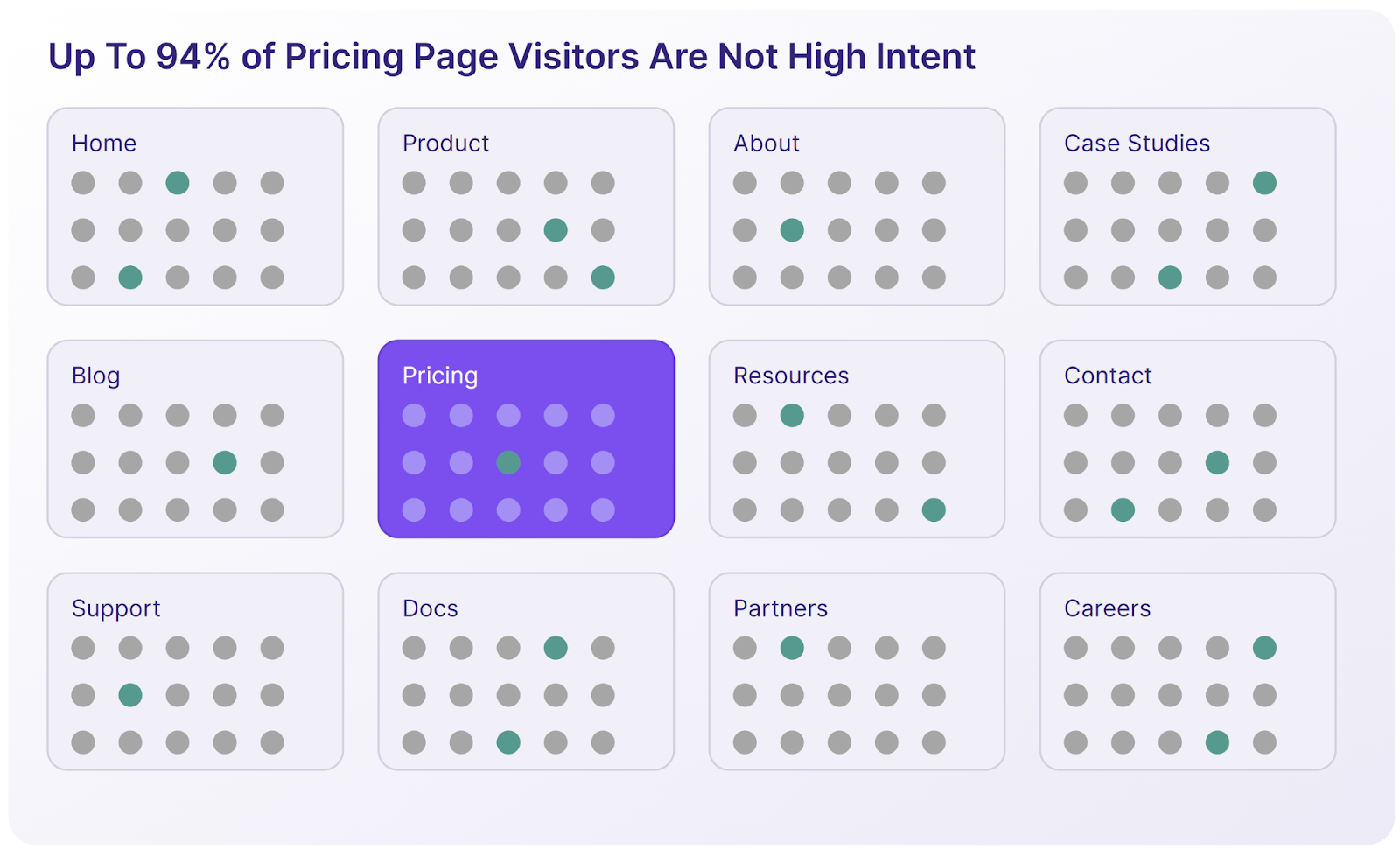
So if you’re using shallow and inaccurate signals from single “high-intent” pages to trigger sales processes - you’re probably wrong more than 9 times out of 10. And if you’re activating marketing and ad campaigns based on this trigger, you’re mostly driving poor quality traffic back to the site.
Meanwhile, all of the real buyers are slipping through the cracks on other pages across the website resulting in missed opportunity. It’s like treating all customers in a retail store that look at a price tag as high intent buyers, without considering all of the other behavioral cues they’ve demonstrated elsewhere.
✅ Solution: 85% Accurate Behavioral Analysis on Every Page
The solution to this problem must span the entire website, not what somebody has assumed is a “high intent page”. We built The ONE Signal to accurately score the specific level of buyer intent of all website visitors across any and every page - based on accumulated AI intelligence from hundreds of micro-behaviors by every visitor, rather than a handful of guesses.
The Hidden Pipeline Problem: Anonymous Website Visitors & Non Hand Raisers
Your biggest GTM opportunity is the hidden buyers visiting your website right now. Up to 97% of your visitors and ad clicks are anonymous and don’t raise their hand, which means you know almost nothing about their level of intent to purchase or buyer journey stage.
And buried in that group of visitors are 10.2% who are high-intent buyers (average) that are actively evaluating solutions like yours – but you don’t know who they are.
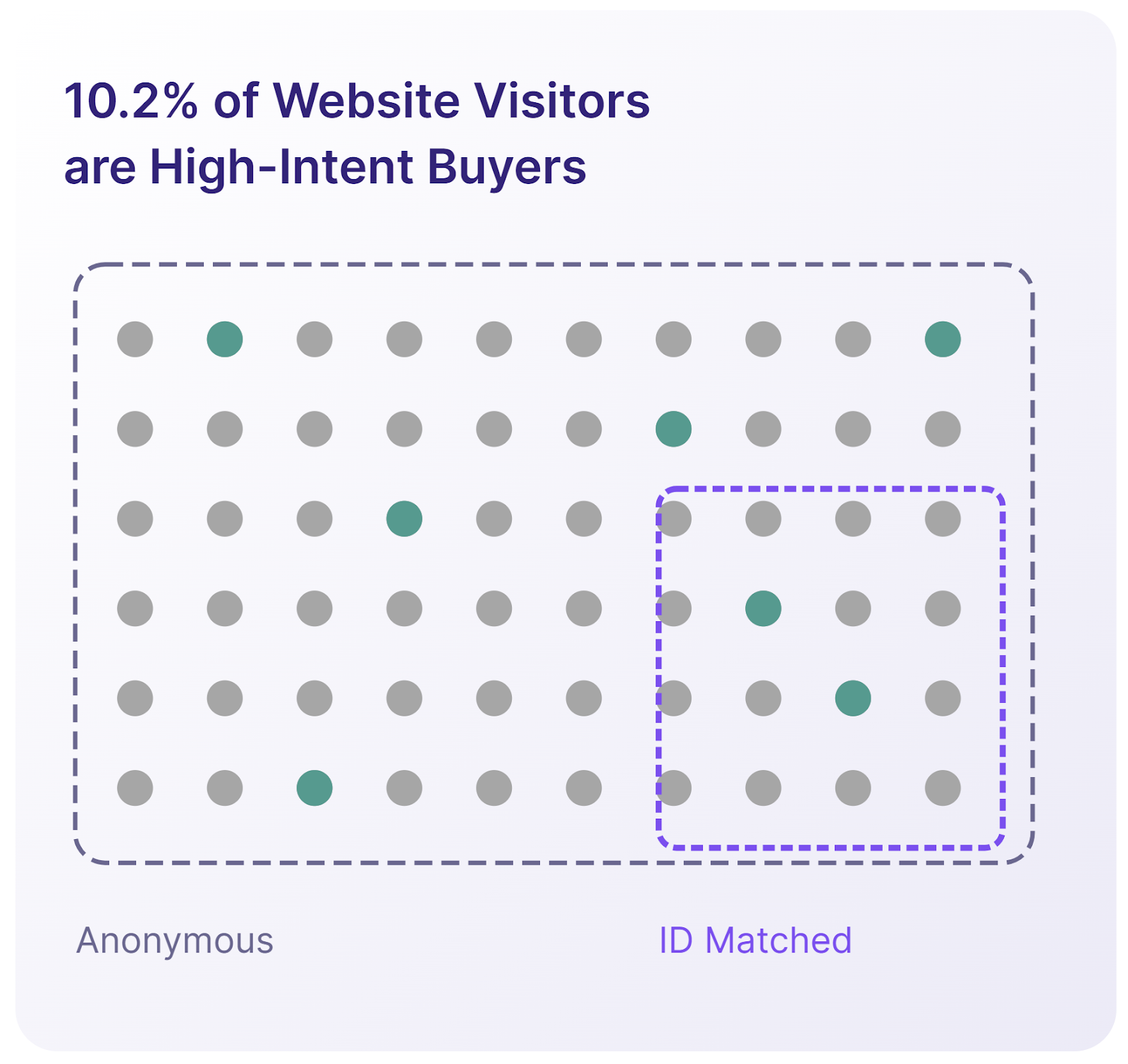
If your website gets 100,000 monthly visitors, roughly 10,000 of them are high-intent buyers, actively evaluating products and solutions. These prospects already know your brand and are a huge hidden pool of potential buyers that Lift AI scores, prioritizes and makes visible in real time.
Meanwhile, most GTM teams are stuck working the tiny fraction of traffic they can actually identify, while chasing too many low-quality leads, because their best buyers are invisible.
The fact is anonymous website visitors remain the single biggest black hole in all of B2B marketing and sales – where too many of your ideal in-market buyers disappear.
✅Solution: Surface All Hidden Buyers on your Website
Lift AI is the only tool that solves this problem. Generating website leads is no longer limited to hand raisers, ID-reveals or specific page visitors. When the ONE Signal fuels your pipeline, 100% of your anonymous website visitors are scored and segmented as First-party data, giving you a powerful competitive advantage by unlocking the untapped value of your website traffic. The buying intent of all your traffic becomes visible, prioritized and ready to fuel GTM growth.
The ABM Problem: Unfulfilled Promises
Nowhere is the impact of bad data more evident than in Account-Based Marketing (ABM). When ABM first emerged a decade ago, it carried bold promises: by aligning Sales and Marketing around a focused list of high-value accounts, teams could finally operate in sync.
With personalized campaigns, precise targeting, and coordinated outreach, ABM was positioned as a breakthrough — transforming volume-driven demand generation into a focused revenue engine built to deliver bigger wins, faster deals and higher sales efficiency.
However, ABM programs underperform because:
- Weak Signals: Many ABM platforms rely on inaccurate third-party “intent data” to drive them, subjecting users to all of the pain points already covered in this article.
- Drowning in Account Lists: ABM platforms contain many thousands of Accounts, but without accurate data to prioritize them, these massive lists are usually just more noise – leaving GTM sales and marketing teams stuck asking “Where do we even start?”
- Missed Opportunities: Without Lift AI, ABM platforms can not see all the High Intent Accounts visiting your website - because they never raise their hand.
- No Personalization at Scale: True account-level customization requires resources most teams don’t have (without Lift AI), so ABM often devolves into generic messaging.
- Sales Skepticism: SDRs and AEs lose team trust when ABM accounts don’t convert.
- Measurement Challenges: Pipelines are influenced by too many channels, making it nearly impossible to track revenue and attribute cleanly to ABM.
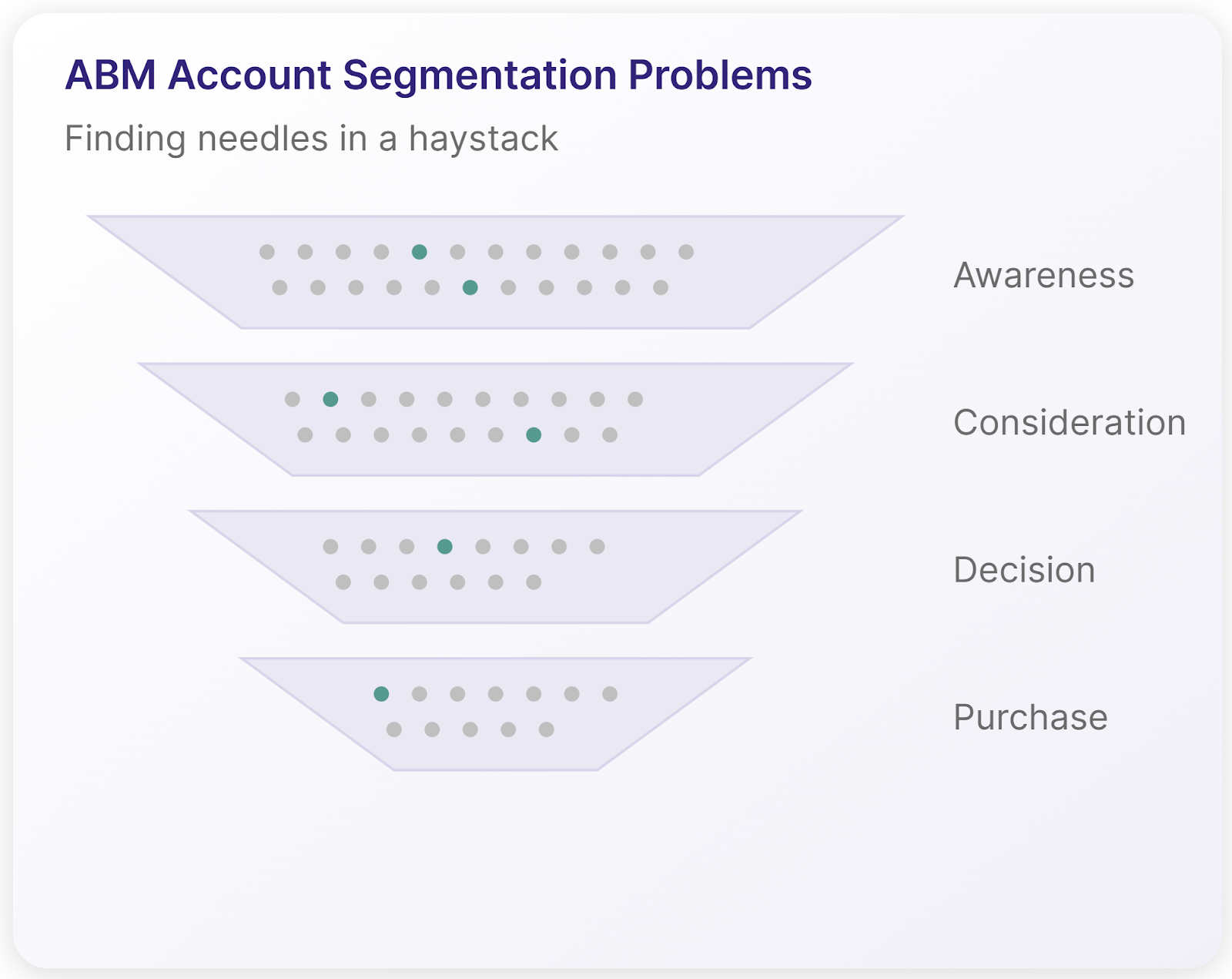
The bottom line: ABM often ends up as more “one size fits all” campaigns, forced to target huge lead lists without actual buyer journey segmentation. Which means marketing doesn't resonate and GTM sales efficiency suffers - which is not the breakthrough that was promised.
The truth is the same as every other GTM tactic: ABM isn’t broken because of its strategy - it’s broken because of bad data inputs.
✅ Solution: Boost Sales Efficiency With Sales-Ready Accounts and Contacts (Even If They Don’t Raise Their Hand)
The ONE Signal delivers the promises of ABM, even if you don't use an ABM platform. With unmatched and proven sales efficiency, Lift AI solves this very difficult problem. Because Sales doesn’t want big lists "in-market" accounts - they want accurate lists of real high intent buyers.
Lift AI uncovers the true intent of all your website visitors, so Marketing can leverage each audience segment by prioritizing and personalizing sales follow up and remarketing activity.
When combined with an ID Reveal or ID Matching tool on your website, you can monetize high intent Accounts and Contacts that don’t raise their hand and would otherwise be ignored.
Importantly, these high intent leads that don’t raise their hand will often convert to pipeline and revenue at dramatically higher rates than low intent handraisers.
Identity Resolution Finds Names and Emails - Not Buyers
Every ID Reveal or ID Matching tool — whether account-level or person-level — only solves part of the challenge. First, they can only identify up to about 30% of your anonymous website traffic. But most importantly - Identity does not equal Intent.
Knowing a name, email, or company doesn’t tell you whether that visitor is ready to buy.
And because ID Reveal lacks accurate behavioral intent signals, the data isn’t actionable for effective sales lead prioritization or personalized messaging across sales, marketing and ad tech. This is true whether it’s an identified Account or more specific to an individual Contact.
This results in every deanonymized visitor being treated as a sales opportunity, which wastes sales resources by prioritizing and following up with poor quality leads.
✅ Solution: Combine Accurate Intent With ID Reveal Technology
When you combine The ONE Signal with an Identity Resolution tool, knowing who is on your website and their email address becomes far more powerful because you also know where they are in their buying journey. This not only helps you prioritize known Accounts and Contacts, but also to uncover all of the hidden pipeline on your website, in real time.
AI Agents Are Limited When Driven By Flawed Data
“95% of enterprise AI pilots fail — not because the AI is flawed, but because the data is.” MIT Research, reported by Fortune Magazine
AI agents and SDRs are one of the hottest trends in sales and marketing — promising to qualify leads, run outreach, and generate pipeline at scale.
However, the reality today is far from proven. Most pilots collapse under the weight of the very same flawed inputs I covered previously - not flawed models.
Even if an AI Agent could engage every website visitor, what playbook would they use to effectively turn visitors into pipeline?
They can’t use a generic one-size-fits-all approach, because that’s proven to result in low conversion rates and visitors that feel interrupted and frustrated.
Instead, they need to understand the visitor’s intent before engaging them, then adjust the messaging and engagement strategy to align with that visitor’s experience, which increases the chances of conversion in the same way it would for a human SDR.
✅ Solution: Feeding AI Agents with Accurate Intent Data (85%+)
With The ONE Signal, AI-powered SDR agents run smarter and faster. Instead of multiplying noise, they run on Lift AI’s proven 85% accurate data, which they need to be a targeted, scalable and trusted revenue-driven solution.
The Speed-to-Lead Problem: Why Faster Isn’t Enough
For years, “speed to lead” has been treated as a response-time challenge: how quickly can you reply once a prospect raises their hand? Companies have added reps, stacked automation, and built entire playbooks around cutting seconds off response times — and most are not optimized.
But here’s the flaw: response time only applies to hand-raisers, and they’re the minority (about 1-3% of traffic).
As already discussed, these hand raisers can be prioritized effectively to engage the high intent leads as quickly as possible, which does improve your response time where it matters.
But most high-intent buyers never fill out a form, request a demo, or download a whitepaper. So while sales teams race to be the “first to respond,” they’re still losing the bigger game — because most real buyers never raise their hand, and they slip by unnoticed.
If there was a way to find and engage these potential buyers before raising their hand, then Speed to Lead becomes an entirely new GTM strategy - beating competition and making response time obsolete.
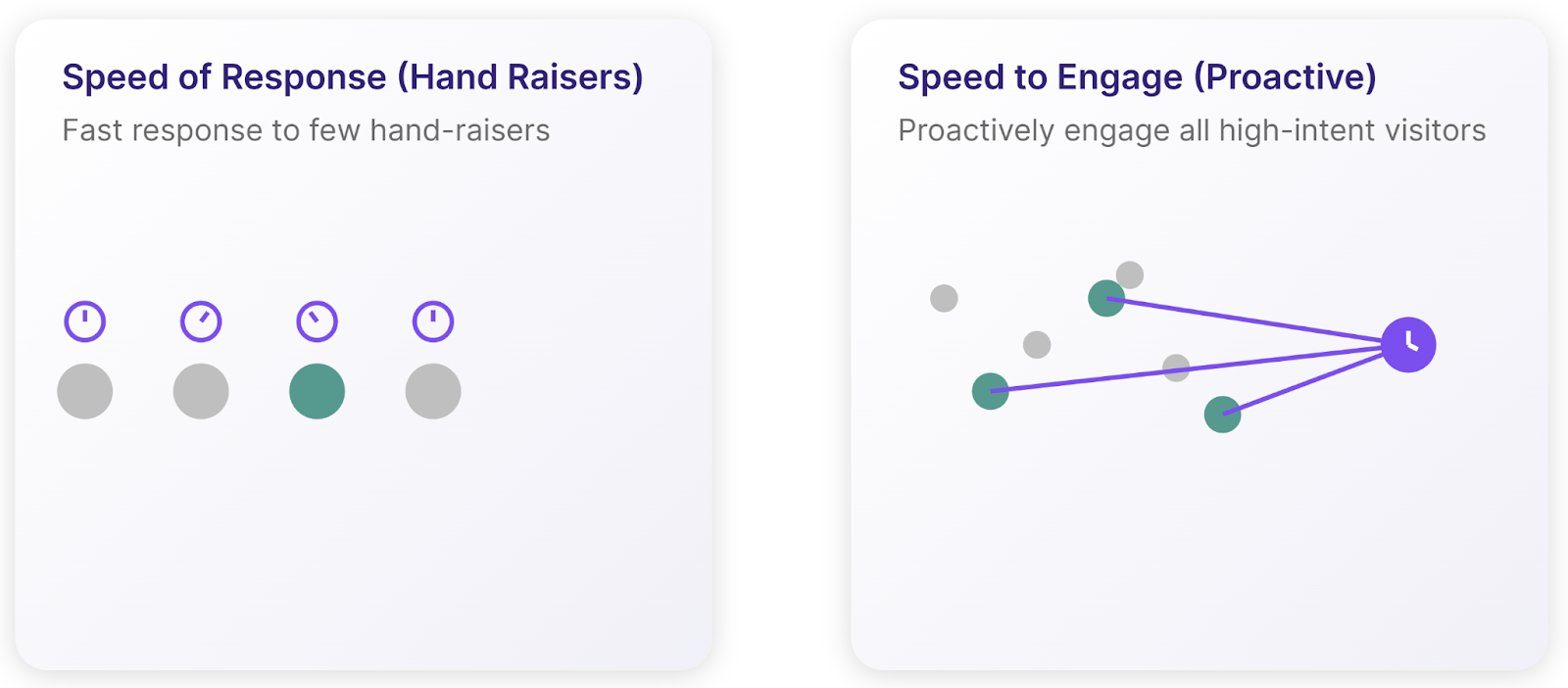
✅ Solution: Real-time and Proactive Speed
The best way to secure deals before competitors isn’t simply to respond faster — it’s to detect and engage high-intent buyers before they ever raise their hand. Only Lift AI does this at scale, since it works in real-time as visitors navigate through the website. And because the model is pre-trained and ready to go out-of-the-box, Lift AI delivers immediate results without any extensive onboarding or training.
Traditional Retargeting Problems: Solved by Lift AI
Retargeting is one of the biggest casualties of data problems, caused by rapid third-party data decay, privacy issues and weak retargeting audiences that never grow. When retargeting budgets get spent across broad audiences - messaging defaults to generic - which means your high intent website visitors don’t get the ad frequency or messaging they need to convert.
The outcome: wasted impressions, inflated CPMs, declining ROAS and rising CAC. Your ad dollars work harder for less bottom-line impact — while real buyers slip further out of reach.
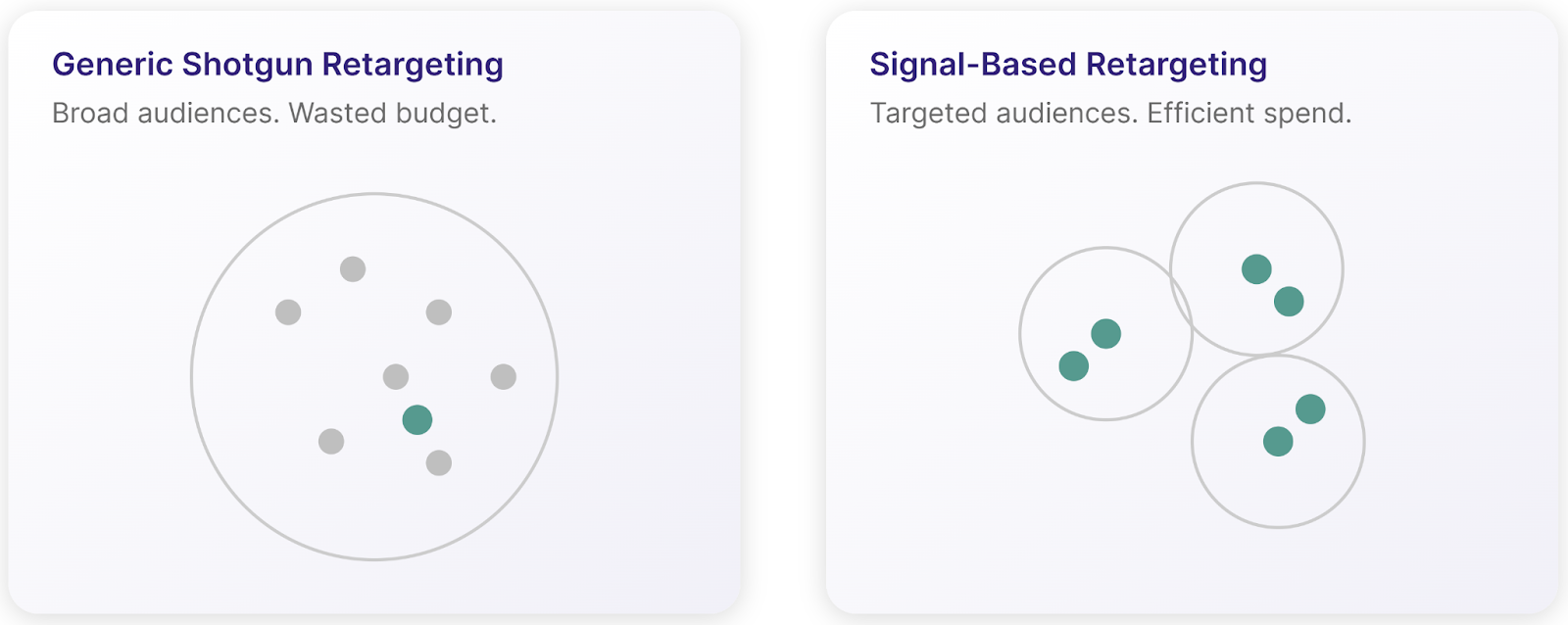
✅ Solution: Intent-Based Retargeting Ads - Even For Anonymous Visitors
The One Signal changes this by enabling you to tailor your ad messaging, channels and ad saturation budgets based on buyer intent levels. Now your high intent audience will see the strong sales-based CTA messaging they need to convert, while mid intent get comparison or evaluation based messaging and low intent gets awareness and educational ad copy.
This opens up a new GTM ad strategy - activating retargeting campaigns for 100% of your website traffic, which no other intent tool can do. And it dramatically increases the number of high intent visitors that return to your website - where they can raise their hand for sales.
Why Your Website + The ONE Signal Is the Key to Sustainable GTM Revenue Growth
Your website is your most valuable GTM asset. Not only is it the “home” of your brand, it hosts your most vital content, showcases your thought leadership, builds trust and authority with your target audience, captures your best leads and generates lots of inbound traffic and pipeline.
But your website isn’t just another channel — it’s the only place where the ONE Signal can possibly exist, because….
- It’s the richest source of First-party data you have, and the only environment with enough behavioral volume to analyze buyer intent accurately.
- Unlike stitched-together datasets from different third-party intent sources, your website data is unified and consistent from the same dataset, making it far more accurate.
- It’s also where the biggest blind spots live: anonymous visitors who can’t be ID-revealed or matched anywhere else, and all the buyers that are missed by traditional First-party signals like “pricing page views”.
- And because your website traffic is the closest asset to revenue — the last stop before conversion — it’s the most significant bottleneck you have right now.
- You’ve already invested heavily to drive traffic to your website. Now it’s time to convert that investment into more pipeline, paying off all of the budget, time, and resources you invested to create its content, optimize user experience and to generate high volumes of targeted traffic.
All of these reasons feed into why Lift AI has become the strongest buyer intent signal. And it proves that your website is also your most untapped resource for immediate pipeline and sustainable GTM revenue growth. Even with all the resources you’ve invested into it, your website’s true potential has never been fully realized - until now - with the ONE Signal.
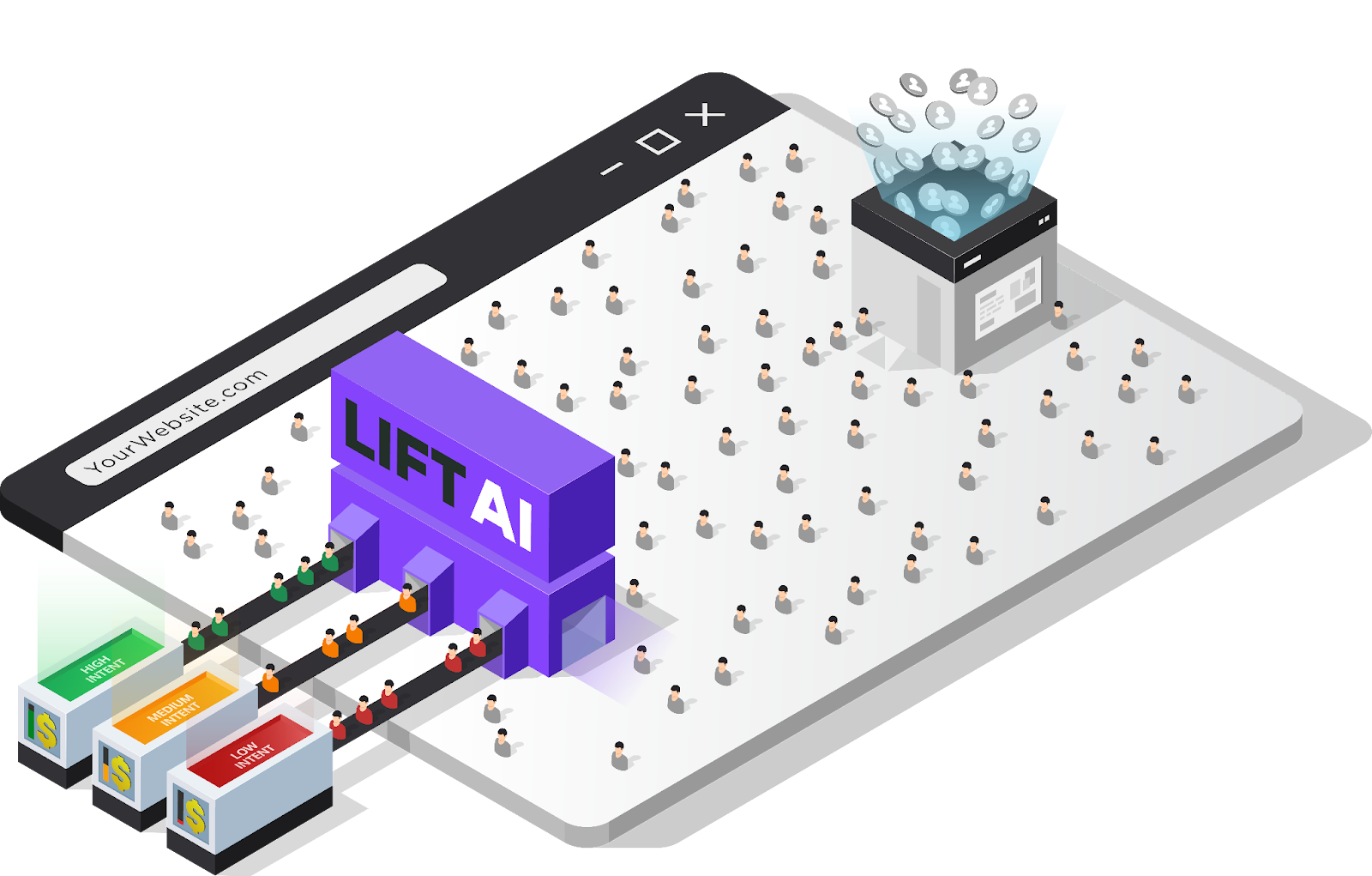
We didn’t realize it when we first built Lift AI for ourselves in order to earn more commission on sales for clients. But after entering the market and seeing the state of intent data as a whole, we realized that we landed with the only possible asset that can solve the problem - your website.
How Lift AI Works And What Makes It Different
Lift AI uses Micro-Behavioral AnalysisTM to score the buyer intent level of every website visitor using scores between 0-100, with over 85% accuracy. It doesn’t need an ID match or any Personally Identifiable Information (PII) to determine these scores, just the visitor behavior alone.
The model is pre-trained using billions of data points and hundreds of millions of sales, across a wide range of B2B and B2C industries and verticals.
Lift AI segments visitor buyer intent scores into granular bands of 5, and groups them into High, Medium, or Low intent, ready for activation across your GTM stack:
- High Intent (65-100): Prioritize and route to live sales workflows ASAP until converted, including lead scoring, chat, form fills, AI SDRs, emails, SMS, and more. Use sales messaging and limited time offers.
- Medium Intent (40-65): Use automation, sequences, and AI SDRs to qualify, nurture, and escalate prospects until they're High Intent and sales-ready. Use evaluative and comparative messaging.
- Low Intent (0-40): Deflect from your live sales resources, then use automation to AI SDRs to educate, support, and influence future opportunities using top-of-funnel positioning and value proposition messaging.
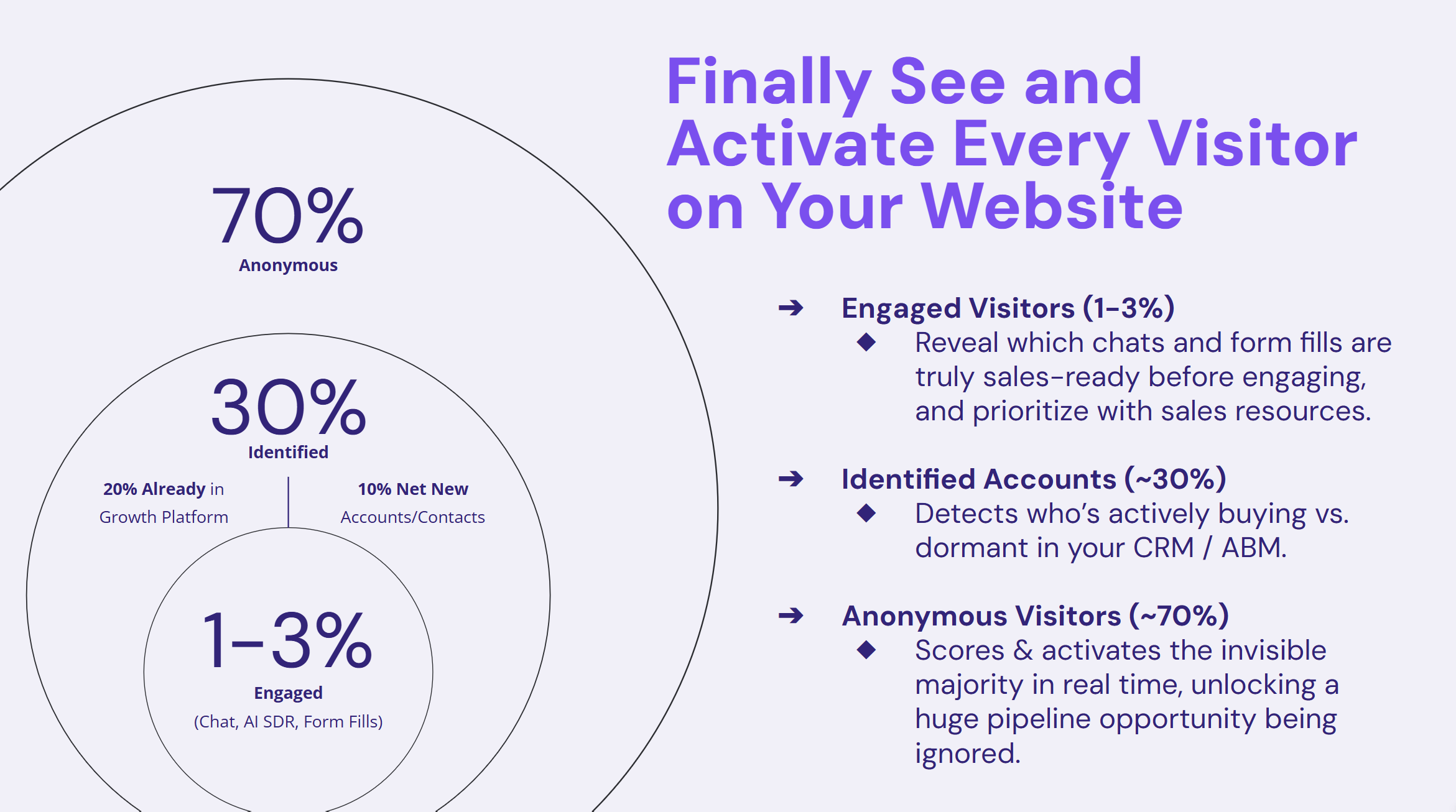
Here’s what makes Lift AI different:
- Scores ALL Visitors: Lift AI scores 100% of your website traffic including anonymous visitors, not just known accounts and contacts.
- Uncovers Hidden Buyers: Surface anonymous and non–hand raising visitors with accuracy, revealing ready-to-activate buyers other tools can’t detect.
- Industry-Leading Accuracy: With 85%+ accuracy, Lift AI eliminates the noise and bias of traditional intent signals to reveal the buyers that truly matter.
- Smarter Prioritization: Know exactly who to engage first and who to deflect, focusing sales, marketing, and ad spend on high-intent buyers who will convert.
- Proactive Engagement (Beyond Speed to Lead): Engage high-intent buyers in real time before they ever raise their hand, gaining a decisive edge over competitors.
- Intent-Aligned Personalization: Match every engagement, campaign, and retargeting ad messaging to each visitor’s real intent, dramatically boosting conversion chances, ROAS, and lowering CAC.
- Seamless Integrations: Lift AI integrates with your entire GTM stack – fueling playbooks and workflows with real-time buyer intent scores and accelerating your entire GTM funnel.
- Immediate Impact: Lift AI’s model is pre-trained and ready to go out-of-the-box and gets measurable results within 30 days with a 100% guarantee (without going through extensive onboarding or training).
- Proven and Trusted: Since 2020, the ONE Signal has delivered transformational results with global enterprise brands like Okta, Payscale, and Boomi.
6 Proven Playbooks To Transform Your Website Into A GTM Revenue Machine
Every ONE Signal Playbook is strategically used to transform your website into your #1 revenue-generating asset, while maximizing every GTM investment tied to it.
From converting and prioritizing engaged visitors to surfacing hidden High Intent Accounts and completely anonymous buyers, Lift AI has compounding impact across every step of your funnel.
For Engaged Visitors (1-3% of Traffic)
The fastest source of immediate pipeline and sales conversions, using the ONE Signal, is to prioritize every high intent website visitor that raises their hand via Chat, Form Fills, or Conversational AI.
The problem with hand raisers is the vast majority are not sales-ready, which means Sales is forced to spend precious time engaging with dead ends while automation provides a generic experience for the leads who are sales-ready, resulting in fewer conversions and missed sales.
With Lift AI, your Sales team and AI SDRs know which visitors are sales-ready so they can instantly be engaged with relevant messaging. and quickly turned into hand raisers. They also know which hand raisers to prioritize next.
No more engaging bad leads with sales reps, no more misaligned AI-driven experiences for the high intent buyers, and no more guesswork.
Playbook #1: Optimize Chat, Conversational AI, and Forms
Lift AI instantly scores every visitor in real time, so you know exactly how to engage them before they raise their hand. This allows you to reduce friction for buyers who are ready to act, tailor the experience for those still evaluating, and capture value from low-intent visitors without wasting sales cycles.
Playbook Steps:
The ONE Signal scores all website visitors in real-time, then:
- Chat, Chatbots, and Conversational AI: When you know the visitor’s intent score before engaging, you can tailor the conversation strategy, timing, and messaging proactively rather than guessing (or incorrectly evaluating) intent mid-conversation or creating a misaligned experience. This dramatically increases the chance of hand raiser conversions at every intent level.
- High Intent (Act Now): Connect to a live rep quickly (who have the highest chance of converting, especially for high consideration purchases), or book a meeting without friction if no rep is available.
- Mid Intent (Educate & Qualify): Share relevant content (case studies, ROI calculators, tours) and run quick Q&A flows to qualify interest. Build momentum and qualify until the buyer is ready to be prioritized for sales.
- Low Intent (Nurture & Support): Qualify and require more information before passing to sales. Use top-of-funnel content downloads, or deflect to support. Keep them warm without wasting sales cycles.
- Use With: Drift, Intercom, Chili Piper, Qualified, Warmly, Marketo, Hubspot, etc.
- Forms: Lift AI scores let your forms adapt in real time, reducing friction for high-intent buyers while adding smart qualification for lower-intent ones. This ensures every submission delivers maximum value without slowing down the conversion experience.
- High & Mid Intent (Fast-Track): Shorten forms to reduce friction, auto-route to reps, and trigger instant follow-ups. Make conversion effortless while intent is highest.
- Low Intent (Qualify): Add extra fields or dynamic questions to assess fit and readiness. Route to nurturing sequences based on answers.
- Use With: Chili Piper, HubSpot Forms, Marketo Forms, etc.
This playbook ensures every engaged website visitor gets the best possible conversion experience on-site, based on where they are at in their buying stage to optimize conversions, pipeline and revenue.
Playbook 2: Intelligently Prioritize Follow-ups
Once visitors get the best possible experience and are engaged, Lift AI ensures your follow-up activities are more efficient after the website visit by prioritizing high-intent leads and deflecting low-intent ones.
Playbook Steps:
The ONE Signal scores all engaged visitors, ready to integrate with your follow-up tools:
- High Intent (Immediate Priority): Prioritize high-intent leads for immediate sales follow-up and personalize the messaging to align with their experience.
- Mid Intent (Personalize & Progress): Use tailored email sequences and sales cadences to move them through evaluation and closer to decision.
- Low Intent (Deflect & Nurture): Deflect low-intent leads instead of wasting sales cycles. Use remarketing automation, targeted ad spend, and AI SDRs to nurture them over time to become high intent.
- Use With: Salesforce, HubSpot, Marketo, Salesloft, Outreach, Gong, etc.
This playbook creates an immediate impact on sales efficiency by deflecting low intent leads, freeing up time to focus on high intent prospects from engaged visitors and hidden buyers.
Engaged Visitor Case Studies
Case Study: Deprioritize Low Intent Handraisers to Eliminate 60% of the Work that Produces Only 8% of Revenue for RealVNC
“Before Lift AI, we were blind to intent. Now, it’s like a cheat code. We doubled conversions in 60 days and finally know which buyers are real.” Justin Wagg, VP Marketing for RealVNC
Watch the Podcast featuring Justin
RealVNC’s website had 15,301 form fill Hand Raisers in one month that automatically got added to their HubSpot Lead Scoring system. After adding Lift AI’s scores, they found that 9,148 (60%) of those were Low Intent and only produced 8% of the revenue. Deflecting these Low Intent Hand Raisers from the sales workflows dramatically increased the RealVNC sales team efficiency while opening up capacity to pursue much better sales other opportunities (see Playbooks #2 and #3). → Read the full case study here.
Case Study: 2x Conversions With AI SDR
“You're not evolving, if you're not optimizing, if you're not testing - you're not going to grow. I think Lift AI provides a lot of that data that helps you grow faster. It helps you optimize your programs, your channels and get better results” Tim Ozmina, Digital Marketing COE @ Boomi
From Tim Ozmina, Digital Marketing COE @ Boomi
Watch the Podcast Featuring Tim
Boomi used Lift AI scores with their conversational AI agent to adjust routing and messaging in real-time. High intent visitors were still directed to live agents who gave human validation and reassurance to sales-ready prospects, while mid and low intent visitors were engaged by conversational AI agent with messaging congruent with their Lift AI intent score.This resulted in a chat-to-pipeline conversion efficiency jump from 3.66% to 8.72% - more than double - while also doubling opportunities booked and delivering their highest every quarterly pipeline from the chat and AI agent combination. → Read the full case study here.
Case Study: 345% More Revenue Per Visitor From Real-time Chat
“Only 6% of high-intent visitors went to the pricing page—meaning 94% of them were completely invisible until we installed Lift AI.” Joel Davis, Fluke Health Solutions
Watch the Podcast featuring Joel
Fluke Health Solutions used Lift AI scores to route high-intent visitors directly into live chat, while lower-intent visitors were guided through self-serve paths. Instead of focusing on “key pages” like the pricing page, they were able to use chat side-wide to capture hand raisers. By focusing efforts on high intent visitors across the entire site, they achieved a 345% increase in revenue per visitor. → Read the full case study here.
Case Study: 3x Conversions and a 5x Bookings from Real-time Chat
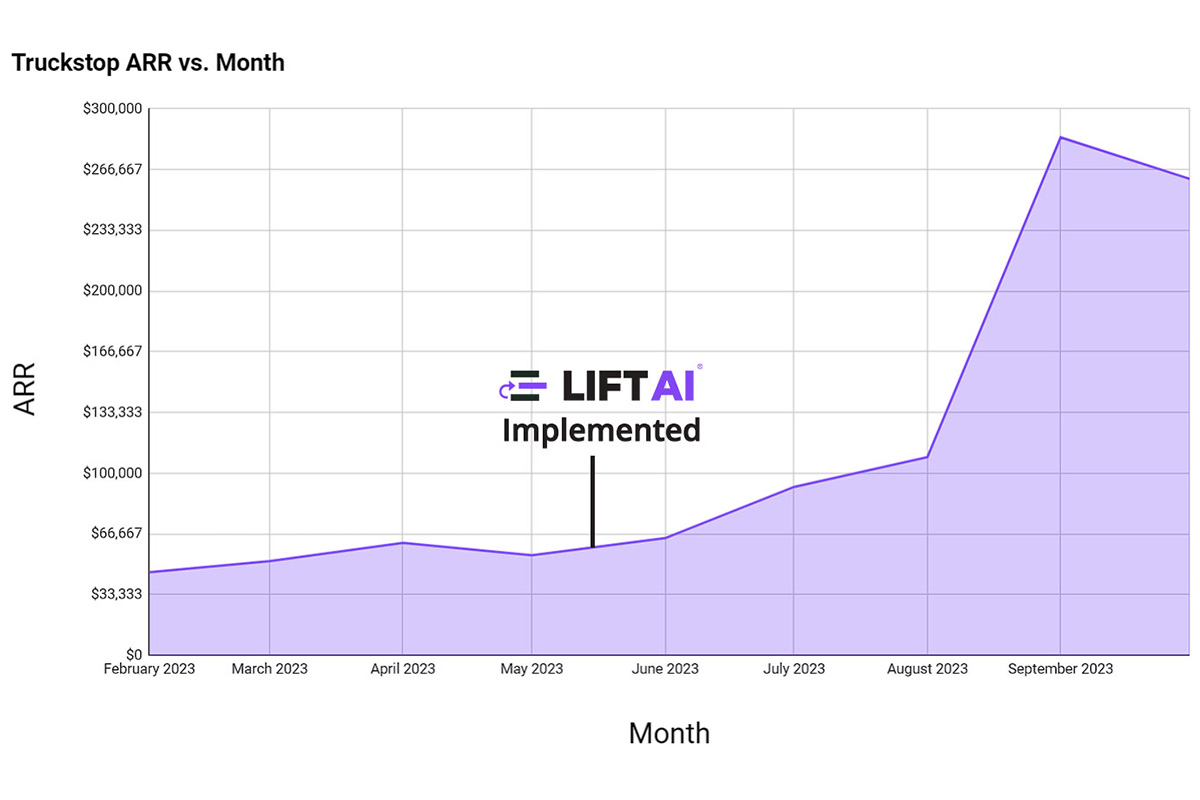
“With Lift AI, we didn’t have to guess who was ready to buy. The ONE Signal gave us clarity and confidence. Our team could focus on the right conversations at the right time — and the ROI spoke for itself.”Tara Rowe, Senior Manager of Ecommerce at Truckstop
Truckstop targeted high-intent website visitors using their chat tool, routing high intent visitors to live agents in real-time who have the best chance of converting compared to chatbots. This resulted in a 3x higher conversion rate for high-intent traffic vs. general traffic (9.72% vs. 3.28%),while cutting the sales cycle in half, and increased bookings from $56k a month to $286k a month in 5 months. → Read the full case study here.
For Identified Accounts and Contacts (~30% of Traffic)
These playbooks fulfill the original promise of ABM - finding in-market accounts and contacts.
After Lift AI’s ONE Signal is combined with ID Match or ID Reveal tools, you can now identify high-intent buyers on your website that don’t raise their hand, then inject that audience directly into your GTM systems for top-priority sales engagement, ABM activation and high-intensity remarketing campaigns to re-engage with these high-intent buyers.
Keep in mind that even with the best ID Reveal and ID Matching tools, only about 30% of your traffic can be account or person-level identified (deanonymized). And within this group only about 10% of them are high intent buyers that are worth prioritizing immediately.
Playbook #3: Activate Hidden Buyers in Matched Accounts (~20% of Traffic)
About 20% of visitors can be ID matched to records already in your CRM. Many show high intent but are ignored because they never raised their hand — which means they’re often missed by lead scoring models and left out of priority target lists.
With Lift AI, those high-intent accounts are scored and injected back into your sales activation workflows in real time - so you no longer skip over sales-ready leads.
Playbook Steps:
The ONE Signal scores all website visitors in real-time to surface high intent visitors.
- ID Match: Use your ID Matching tool to match those high intent visitors with existing Accounts or Contacts already in your GTM Platforms.
- High Intent (Add to Prioritization): Route matched high-intent accounts and contacts straight into sales priority workflows.
- Mid Intent (Personalize & Progress): Use tailored email sequences and sales cadences to move them through evaluation and closer to decision.
- Low Intent (Warm Up): Keep them in your ecosystem with light-touch nurture, remarketing, or awareness ads, ensuring they don’t fall off your radar.
- Use With: Hubspot, Salesforce, 6Sense, Dembandbase, Marketo, Salesloft, etc.
This playbook is all about finding those hidden buyers in Accounts that you’re already targeting, but don’t realize they’re demonstrating buying signals on your website right now.
Playbook #4: Discover And Prioritize Net-new Accounts (~10% of Traffic)
Roughly 10% of your website visitors can be ID revealed as net-new accounts that are not yet in your GTM Platforms. These need to be checked for ICP fit and then segmented by Lift AI intent scores to uncover the net-new, truly sales-ready opportunities.
Once segmented, inject those high-intent net-new accounts into your ABM and sales activation, expanding your total opportunity without the noise of low-quality matches.
Playbook Steps:
The ONE Signal scores all website visitors in real-time:
- ID Reveal: Then Use your ID Reveal tool to identify those high intent visitors as Accounts or Contacts
- Use With: 6Sense, Clearbit, Zoominfo, SalesIntel, RB2B, Visual Visitor, Vector, etc.
- Enrich: Use your CRM enrichment tool and other data to run an ICP fit check against those High Intent Accounts and Contacts
- Use With: Apollo, Zoominfo, Clay
- If they are an ICP fit:
- High Intent (Add to Prioritization): Route matched high-intent accounts and contacts straight into sales priority workflows.
- Mid Intent (Personalize & Progress): Use tailored email sequences and sales cadences to move them through evaluation and closer to decision.
- Low Intent (Warm Up): Keep them in your ecosystem with light-touch nurture, remarketing, or awareness ads, ensuring they don’t fall off your radar.
- Use With: Hubspot, Salesforce, 6Sense, Dembandbase, Marketo, etc.
This playbook is all about expanding your pipeline beyond what’s already in your CRM, finding net-new Accounts and Contacts that you wouldn’t have considered without seeing their buying intent from Lift AI.
Identified Accounts and Contacts Case Studies
Case Study: ID Matched Non Hand Raisers in HubSpot CRM for Untapped Revenue
RealVNC combined Lift AI scores with ID Matching to find Accounts on their website that were not raising their hand but had high buyer intent. Just 190 of these leads generated 2.34x the revenue of 9,148 Low Intent Hand Raisers captured from hand-raising form fills over the same period. This highlights how Lift AI’s intent accuracy transforms your GTM model from chasing volume to prioritizing precision with significant impact on pipeline, revenue and sales efficiency.
Case Study: Deeper ABM Segmentation in 6Sense for 19x Efficiency
Payscale added Lift AI scores to their 6sense Account Scoring implementation to help find sales-ready Accounts within their sizable existing segments. Before Lift AI, their 6Sense Account “Purchase” Stage had 151,475 Accounts converting at 0.51%. After Lift AI, they narrowed that down to just 2,307 High Intent Accounts converting at 10.64%, a 19x increase in conversion efficiency. → Read the full case study here.
“Adding Lift AI’s individual buyer intent scores to 6sense Account Stages led to much smaller, higher converting segments.” Matthew Philips, Marketing Technology & Operations Officer, Payscale
Case Study: “Bullseye” ABM Segments For 11.9x Conversions
Chronus integrated Lift AI scores with their 6Sense Account data to pinpoint the “bullseye” of High Intent Accounts that matched their ICP but didn’t raise their hand. Out of a broad 6Sense segment that had been delivering low yield, Lift AI isolated a much smaller pool of truly sales-ready Accounts. That focus led to an 11.9x lift in conversion rates and doubling pipeline compared to the 6Sense segment on its own. → Read the full case study here.
“By combining Lift AI buyer intent scores with our 6Sense Buying Stage, we increased conversions from 3.4% to 39.3% - an 11.6x sales efficiency impact.” Director of Demand Generation - Mike Kang, Chronus
Case Study: Finding the Needle in the Haystack of Net New Buying Accounts
By combining Lift AI’s intent scores with ID Reveal, RealVNC surfaced 109k new accounts on their website that were not in their CRM. After filtering for ICP fit, that number dropped to 25k. But with Lift AI’s behavioral scoring, only 962 were High Intent. This precision meant their sales team could focus on the small fraction of accounts most likely to convert, instead of chasing tens of thousands of false opportunities — dramatically improving efficiency and accelerating pipeline.
“Having something like Lift AI is really revolutionized the way we do our lead scoring because now we're still running all of those mechanics, but on top of it, we're simply saying, 'If Lift AI is scored it as high intent, that goes immediately over to our sales reps, and we treat it basically like a hot lead.” Justin Wagg, VP Marketing for RealVNC
For Anonymous Visitors (~70% of Traffic)
More than 70% of your website visitors are completely anonymous — invisible to Identity Resolution, ID matching, and hand-raising tools. You have already invested in driving these prospects to your website to engage with your brand, so they should not be ignored. They are by far your single largest source of hidden buyers and untapped GTM revenue. With Lift AI, anonymous no longer means untouchable.
Playbook 5: Optimize Website Visitor Experience
Lift AI scores every visitor in real time, allowing your site to dynamically show the most relevant content to each audience and conduct intent-based A/B testing. High-intent buyers get strong CTAs or offers, mid-intent are shown evaluative content and low-intent browsers see awareness content.
Playbook Steps:
The ONE Signal scores all website visitors in real-time to influence their on-page experience:
- High Intent (Convert Now): Trigger strong CTA buttons, banners, pop-ups, or personalized offers that encourage immediate action — from demo requests to discounts.
- Mid Intent (Evaluate & Compare): Swap content for case studies, comparison tables, or product tours to build trust and move them closer to conversion.
- Low Intent (Build Awareness): Deliver high level value proposition content or awareness messaging. Encourage them to explore further.
- Use With: Optimizely, VWO, Mutiny, Webflow
This playbook is all about adjusting the on-page experience for each visitor based on their intent, increasing the chances of getting them to engage.
Playbook #6: Optimizes Retargeting Campaigns
Traditional retargeting has long been a top-performing advertising tactic, but today ROAS is collapsing with 3rd-party cookie loss and privacy issues. The ONE Signal fixes this.
When anonymous visitors leave your website, Lift AI ensures they don’t disappear into the noise. Focused ad spend with personalized messaging and saturation based on intent scores dramatically increases the number of repeat visits and future conversions from your traffic.
Playbook Steps:
The ONE Signal scores all website visitors in real-time to optimize your retargeting strategy:
- High Intent (CTA Focus): Prioritize with the highest ad frequency and budget, sales-based CTAs (e.g. “Limited Time Discount”), and ads on multiple channels to re-engage and convert prospects who are most likely to buy.
- Mid Intent (Nurture Back): Use more contextual ads with moderate saturation and budget across fewer channels, using proof points (case studies, product value, ROI calculators) to build confidence and pull them back to your site.
Low Intent (Awareness): Keep a light, awareness-level presence with lower saturation and budget through key ad channels, using value proposition ads to keep your brand top-of-mind to bring visitors back to your website, until their intent rises. - Use With: Google Ads, LinkedIn Ads, Meta Ads, Bing Ads, AdTech platforms, etc.
This playbook fulfills the full potential of retargeting - by using accurate intent signals to saturate ad spend by intent level and creating relevant messaging on ad campaigns to drive visitors back to your website - all based on your target audiences’ buying stage.
Anonymous Visitor Case Studies
Case Study: 10% Revenue Increase With On-Page CRO
RealVNC integrated Lift AI scores into their conversion rate optimization (CRO) experiments within VWO. By dynamically adjusting which banners were shown to each visitor segment (such as highlighting limited-time discounts for high-intent buyers) and tailoring call-to-action button language based on visitor intent, they created a more personalized onsite experience that drove a 10% increase in webshop revenue within the first 60 days of implementation. → Read the full case study here.
“What we're doing is we're just looking at the real-time behavior of the visitor as they navigate the website. And something that's really exciting is we're using something like VWO to personalize the content on the website." Justin Wagg, VP Marketing for RealVNC
Case Study: Turning Anonymous Visitors Into 64% of Hand Raiser Pipeline
Intelex discovered that 85% of their website traffic was anonymous, but by applying Lift AI scores to shape the onsite experience, they were able to surface more of these hidden buyers and influence their journey with the right Chat messaging invitation to convert them into hand raisers. The result: 85% of the website’s traffic were anonymous visitors, and once invisible, ended up driving 64% of the total pipeline.
"24% of our Conversations in Drift are with completely anonymous visitors that are scored High or Mid Intent by Lift AI. The effectiveness of Lift AI’s intent scoring is evident in the fact that those visitors represent 56% of our Drift Influenced Opportunities, and they convert to Opportunity 4x more efficiently." Jennifer Boudreau, Director Revenue Operations at Intelex
Case Study: Doubled Leads and 67% CPL Reduction With Retargeting
RealVNC also extended Lift AI scores into their retargeting strategy on the Google Display Network. Rather than treating all retargeted visitors the same, they used Lift AI to segment audiences by intent and then built campaigns that focused spend only on those with the highest likelihood to convert. This approach allowed them to double the number of leads generated from retargeting while holding spend flat, driving a 67% reduction in cost per lead (CPL). → Read the full case study here.
“What we found is starting, like we've literally seen a 67% decrease in cost per lead or acquisition cost for remarketing to all of our high intent traffic as opposed to just that traditional group.” Justin Wagg, VP Marketing for RealVNC
Resolving a Root Cause of GTM Problems
The only way to solve an intractable problem is to first identify its underlying root cause.
For most seasoned enterprises, the root cause of slow GTM growth is low-quality sales leads created by low-quality data inputs. Specifically - inaccurate intent data and false signals.
Without accurate high-quality sales leads, pipeline velocity stalls. Deals drag on. Handoffs to Sales create friction, frustration sets in and competitors win - simply by engaging earlier.
Lift AI solves this broken GTM engine problem at the source.
By detecting and scoring real-time buyer intent of every website visitor, the ONE Signal injects 85%+ accurate and prioritized buyer intent signals directly into your GTM system, which…
- Fuels faster sales conversions
- Boosts immediate sales results
- Optimizes sales team efficiency
- Prioritizes sales follow-up actions
- Enhances every tool in your stack
- Optimizes your GTM resources
- Boosts retargeting ads ROAS
- Leverages existing website traffic
- Creates GTM team alignment
- Drives sustainable GTM growth
From One Question to The ONE Signal
The question starting my journey:
“How can I give my sales team more sales-ready leads?”
...has led us to the ONE Signal - the most accurate buyer intent prediction model ever built.
Backed by years of enterprise case studies and built on a unique and rock solid foundation of AI and machine learning - using billions of website visits, micro-behavioral data points and millions of tracked sales conversions - the ONE Signal is now available to your GTM team.
With the ONE Signal, GTM leaders finally have a proven tool that delivers what we’ve all been searching for - high volumes of buyer journey leads and sales ready buyers. Because when you know exactly who’s ready to buy - every other GTM action becomes easier.
Start Using The ONE Signal In Minutes And See Results in 30 Days - Guaranteed
Now you can put it to work yourself, risk-free. And you won’t wait months to see results.
Install Lift AI’s 30-Day Free Trial script in just five minutes, and you’ll start uncovering hidden buyers on your website immediately.
After 30 days, you’ll see a clear attribution report showing the incremental pipeline and revenue Lift AI can deliver when integrated with your GTM tools.
And with Lift AI’s Performance Guarantee, you can protect your investment in Lift AI past those 30 days and only pay if you get measurable return (subject to Terms and Conditions).
Stop feeding your GTM engine with bad data, and start feeding it with the ONE Signal that turns your website into the source of truth and revenue machine it was meant to be.


